Murcia |
|
|
|
| Übersicht – Contents: | |
Diese Seite ist Teil des Projektes
Murcia |
|
|
|
| Übersicht – Contents: | |
Flagge – Flag: |
|
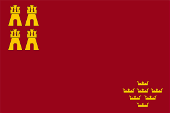 |
Flagge von Murcia |
| historische und andere Flaggen – historical and other Flags: | |
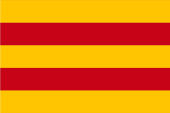 |
1243–1281, |
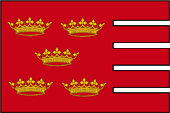 |
1281-1361, |
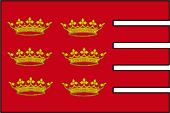 |
1361, |
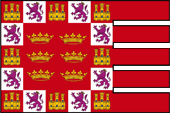 |
ab
1361, |
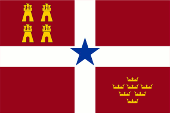 |
Flagge lokaler Nationalisten |
| Die Flagge von Murcia wurde am 05.05.1979 erstmals offiziell gehisst und mit der Annahme des Autonomiestatuts am 09.06.1982 per Gesetz für die autonome Gemeinschaft Murcia übernommen. Unter der der Regierung des Generals Franco (1936–1975) waren alle regionalen Flaggen verboten. Nach Francos Tod (1975) wurden die regionalen Flaggen wieder eingeführt, bzw. neue geschaffen. Murcia hatte vorher keine eigene Flagge mehr, so dass 1979 das heutige Modell eingeführt wurde. Die Flagge ist einfarbig karmesinrot (eigentlich Cartagena-Rot oder Blutrot) und zeigt in der Oberecke vier goldene Burgen und im wehenden Teil sieben goldenen Kronen. Die vier Burgen sind der Heraldik von Kastilien entnommen und erinnern daran das Murcia ein Kastilisches Königreich war und zur Kastilischen Krone gehörte. Die Zahl vier steht für die vier großen Außengrenzen des Landes, in Richtung Aragon, Kastilien, Andalusien und Mittelmeer. Die sieben Kronen wurden dem Land nach und nach, jedoch beginnend bei fünf, von Königen verliehen. Ganz zu Beginn des Kastilischen Königreichs Murcia, im 13./14. Jahrhundert, soll das Land eine goldene Flagge mit zwei horizontalen roten Streifen besessen haben. Alfons X., König von Kastilien, verlieh der Stadt und dem Königreich am 14.05.1281 Flagge und Banner, einfarbig rot mit fünf goldenen Kronen darin. Damit sollte daran erinnert werden, das Murcia das fünfte Königreich war, das von der Krone Kastiliens erobert wurde. Die sechste Krone wurde von König Pedro I. am 04.05.1361 verliehen, weil das Königreich Murcia während der Peterskriege treu zu Kastilien gestanden hatte. Noch im selben Jahr wurde ein üppiges Wappenbanner eingeführt. Die siebente Krone wurde am 16.09.1709 von König Philipp V. verliehen, weil das Königreich Murcia ihn während des Spanischen Erbfolgekrieges unterstützt hatte. Das widerspiegelt sich bis heute im Stadtwappen von Murcia. Dass es auch eine Flagge mit sieben Kronen für das Königreich gegeben hätte, ist nicht bekannt. Wahrscheinlich wurde das letzte Modell der Flagge von 1361 irgendwann nicht mehr verwendet. Das Königreich endete 1833 und wurde in die Provinzen Albacete und Murcia aufgeteilt. Seit 1982 gehört Albacete zu Kastilien-La Mancha. Das Rot der heutigen Flagge wird Cartagena-Rot genannt, es ist am besten mit Blutrot zu vergleichen. Die Wahl der Farbe erfolgte zufällig und wurde willkürlich als Cartagena-Rot bezeichnet. |
The flag of Murcia was
officially hoisted for the first time on 5th of May in 1979 and was adopted
by law for the Autonomous Community of Murcia with the adoption of the
Statute of Autonomy on 9th of June in 1982. Under General Franco's
government (1936–1975), all regional flags were banned. After Franco's death
(1975), the regional flags were reintroduced or new ones were created.
Murcia no longer had its own flag, so the current model was introduced in
1979. The flag is plain crimson red (actually Cartagena red or blood red) and shows four golden castles in the upper corner and seven golden crowns in the flying part. The four castles are taken from the heraldry of Castile and remind us that Murcia was a Castilian kingdom and belonged to the Castilian Crown. The number four stands for the country's four major external borders, towards Aragon, Castile, Andalusia and the Mediterranean. The seven crowns were gradually awarded to the country by kings, starting with five. At the very beginning of the Castilian Kingdom of Murcia, in the 13th/14th century, the country is said to have had a golden flag with two horizontal red stripes. Alfonso X., King of Castile, awarded the city and the kingdom a flag and a banner on 14th of May in 1281, plain red with five golden crowns in it. This was to remember that Murcia was the fifth kingdom to be conquered by the Crown of Castile. The sixth crown was awarded by King Pedro I. on 4th of May in 1361 because the Kingdom of Murcia had remained loyal to Castile during the Peter's Wars. In the same year, a lavish heraldic banner was introduced. The seventh crown was awarded on 16th of September in 1709 by King Philip V. because the Kingdom of Murcia had supported him during the War of the Spanish Succession. This is still reflected today in the coat of arms of the City of Murcia. It is not known that there was a flag with seven crowns for the kingdom. It is likely that the last model of the flag from 1361 fell out of use at some point. The kingdom ended in 1833 and was divided into the provinces of Albacete and Murcia. Albacete is a part of Castile-La Mancha since 1982. The colour red of the today's flag is called Cartagena red, it is best compared to blood red. The choice of color was random and was arbitrarily named Cartagena Red. |
| Quelle/Source: Wikipedia (ES), Flags of the World, Volker Preuß | |
Wappen – Coat of Arms: |
|
 |
seit/since 1982, Wappen von Murcia – coat of arms of Murcia, Quelle/Source, nach/by: Wikipedia (DE) |
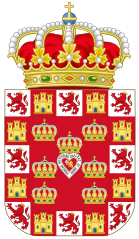 |
heutiges Wappen der Stadt Murcia – today's coat of arms of the City of Murcia, Quelle/Source, nach/by: Heralder, CC BY-SA 4.0, via Wikimedia Commons |
historische Wappen – historical Coats of Arms: |
|
 |
1266-1361, Wappen des Königreichs Murcia – coat of arms of the Kingdom of Murcia, Quelle/Source, nach/by: Wikipedia (ES) |
 |
ab 1361, Wappen des Königreichs Murcia – coat of arms of the Kingdom of Murcia, Quelle/Source, nach/by: Wikipedia (ES) |
| Das Wappen von Murcia wurde 1982 geschaffen und ist von der Gestaltung her an der Flagge orientiert, lediglich ein umlaufender goldener Rand weicht hier ab. Am 04.05.1983 wurde es per Gesetz für die autonome Gemeinschaft Murcia übernommen. Es ist einfarbig karmesinrot (eigentlich Cartagena-Rot oder Blutrot) und zeigt in der Oberecke vier goldene Burgen und gegenüber sieben goldenen Kronen. Die vier Burgen sind der Heraldik von Kastilien entnommen und erinnern daran das Murcia ein Kastilisches Königreich war und zur Kastilischen Krone gehörte. Die Zahl vier steht für die vier großen Außengrenzen des Landes, in Richtung Aragon, Kastilien, Andalusien und Mittelmeer. Die sieben Kronen wurden dem Land nach und nach, jedoch beginnend bei fünf, von Königen verliehen. Alfons X., König von Kastilien, verlieh der Stadt und dem Königreich am 14.05.1281 ein einfarbig rotes Wappen mit fünf goldenen Kronen darin. Ein umlaufender Rand wechselte die Symbolik von Kastilien und Leon. Mit den fünf Kronen sollte daran erinnert werden, das Murcia das fünfte Königreich war, das von der Krone Kastiliens erobert wurde. Die sechste Krone wurde von König Pedro I. am 04.05.1361 verliehen, weil das Königreich Murcia während der Peterskriege treu zu Kastilien gestanden hatte. Die siebente Krone wurde am 16.09.1709 von König Philipp V. verliehen, weil das Königreich Murcia ihn während des Spanischen Erbfolgekrieges unterstützt hatte. Das widerspiegelt sich bis heute im Stadtwappen von Murcia. Das Rot im Wappen wird Cartagena-Rot genannt, es ist am besten mit Blutrot zu vergleichen. Die Wahl der Farbe erfolgte zufällig und wurde willkürlich als Cartagena-Rot bezeichnet. |
The coat of arms of
Murcia was created in 1982 and its design is based on the flag, with the
exception of a golden border. On 4th of May in 1983 it was adopted by law
for the autonomous community of Murcia. It is plain crimson (actually Cartagena red or blood red) and shows four golden castles in the upper corner and seven golden crowns opposite. The four castles are taken from the heraldry of Castile and remind us that Murcia was a Castilian kingdom and belonged to the Castilian crown. The number four represents the four great external borders of the country, towards Aragon, Castile, Andalusia and the Mediterranean. The seven crowns were granted to the country progressively, but starting with five, by kings. Alfonso X, King of Castile, granted the city and the kingdom a plain red coat of arms with five golden crowns in it on 14 May 1281. A surrounding border changed the symbolism of Castile and Leon. The five crowns were intended as a reminder that Murcia was the fifth kingdom to be conquered by the Crown of Castile. The sixth crown was awarded by King Pedro I on 04.05.1361 because the Kingdom of Murcia had been loyal to Castile during the St Peter's Wars. The seventh crown was awarded by King Philip V on 16.09.1709 because the Kingdom of Murcia had supported him during the War of the Spanish Succession. This is still reflected today in the coat of arms of the city of Murcia. The red in the coat of arms is called Cartagena red, it is best compared to blood red. The choice of colour was random and arbitrarily named Cartagena Red. |
| Quelle/Source: Wikipedia (ES), Flags of the World, Volker Preuß | |
|
Die autonomen Regionen Spaniens – The autonomous Regions of Spain: Interaktive Landkarte - interactive map |
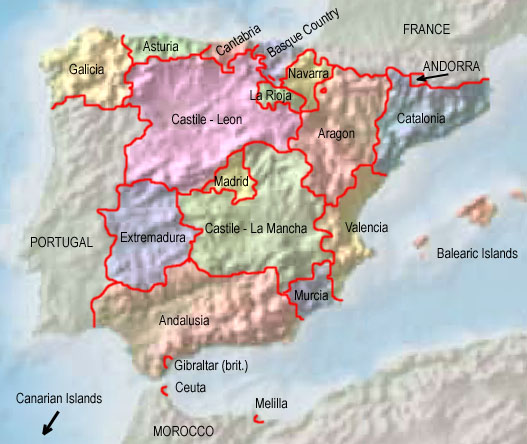 |
| Quelle/Source: Freeware, University of Texas Libraries, modyfied by: Volker Preuß |
| Zahlen und Fakten – Numbers and Facts: | |
|
|
|
|
|
|
|
|
|
|
|
|
|
|
|
|
|
|
|
Frühzeit
· Besiedlung durch Iberer ca. 600 v.Chr. · Einwanderung von Kelten, Vermischung mit den Iberern, Herausbildung der Keltiberer 228 v.Chr. · der karthagische Heerführer Hasdrubal (Bruder des Hannibal) gründet an der Küste Iberiens – die zum Reich Karthago gehört – die Stadt Carthago Nova (das heutige Cartagena) 218–201 v.Chr. · Zweiter Punischer Krieg, das Römische Reich erwirbt die Besitzungen Karthagos in Iberien, Unterwerfung der ganzen Iberischen Halbinsel bis zum Jahre 19 v.Chr., römische Besiedlung, Romanisierung, das heutige Murcia gehört je zur Hälfte zu den römischen Provinzen Baetica und Hispania Taraconensis 415–418 n.Chr. · Ankunft der Westgoten im Rahmen der Völkerwanderung, das heutige Murcia wird Teil des Westgotenreiches 425 · die germanischen Vandalen erobern und zerstören Carthago Nova 6. Jahrhundert · die Iberische Südküste kommt an das Oströmische Reich (Byzanz) 711–714 · Vernichtung des Westgotenreichs durch von Nordafrika kommende Araber, die Westgoten ziehen sich nach Asturien und Kantabrien zurück, das heutige Murcia wird von den Arabern besetzt, Gründung des Arabischen Emirates von Cordoba, Arabisierung, Islamisierung 825 · Neugründung der Stadt Murcija durch die Araber auf den Ruinen der römischen Stadt Murcia 929 · das Emirat von Cordoba wird zum Arabischen Kalifat Cordoba unter der Dynastie der Omajjaden umgebildet 1010 · Sturz der Omajjaden-Dynastie, bis 1040 zerfällt das Reich in mehrere arabische Königreiche (z.B.: Malaga, Algeciras, Granada, Cordoba, Toldeo, Valencia, Zaragoza, Denia, Murcia und Badajoz) 1063 · Abd Er Rahman ibn Tahir erklärt sich von Valencia unabhängig und gründet das Königreich Murcia (bis 1243) 1243 · die Stadt Murcia wird durch Alfons X. von Kastilien und seinen Truppen von den Arabern befreit, Gründung des Kastillischen Königreichs Murcia 1829 · die Stadt Murcia wird durch ein schweres Erdbeben vollständig zerstört 1833 · die bis dato in Spanien bestehenden Teilkönigreiche und Regionen werden in Provinzen aufgeteilt, das Königreich Murcia wird in die Provinzen Albacete und Murcia aufgeteilt, seit 1982 gehört Albacete zu Kastilien-La Mancha 09.06.1982 · Murcia erhält das Autonomiestatut innerhalb Spaniens, Gründung der "Autonomen Gemeinschaft Murcia" |
|
early age
· settlement of Iberians ca. 600 B.C. · immigration of Celts, mix with the Iberians, evolution of the Celtiberians 228 B.C. · the Carthagian General Hasdrubal (brother of Hannibal) erects on the coast of Iberia – which belongs to the Empire of Carthago – the City of Carthago Nova (the today’s Cartagena) 218–201 B.C. · Second Punic War, the Roman Empire acquires the possessions of Carthago in Iberia, subjugation of whole Iberia until the year 19 B.C., Roman settlement, romanization, the today’s Murcia comes fifty-fifty to the Roman provinces of Baetica and Hispania Taraconensis 415–418 A.D. · arrival of the Western Goth in context of the Great Transmigration (Migration Period), the today’s Murcia becomes a part of the Empire of the Western Goth 425 · the Teutonic Vandals conquer and destroy Carthago Nova 6th century · the Iberian south coast comes to the East Roman Empire (Byzantium) 711–714 · annihilation of the Empire of the Western Goth by from northern Africa coming Arabs, the Western Goth retreat to Asturia and Cantabria, the south of the today's Murcia becomes occupied by the Arabs, establishment of the Arabian Emirate of Cordoba, arabization, islamization 825 · re-foundation of the City of Murcija on the ruins of the Roman town Murcia 929 · the Emirate of Cordoba becomes transformed ot the Arabian Califate of Cordoba under the dynasty of the Omajjads 1010 · overthrow of the Omajjads dynasty, to 1040 disintegrates the empire in some arabian kingdoms (E.G.: Malaga, Algeciras, Granada, Cordoba, Toldeo, Valencia, Zaragoza, Denia, Murcia and Badajoz) 1063 · Abd Er Rahman ibn Tahir declares his independence from Valencia and establishes the Kingdom of Murcia (until 1243) 1243 · Murcia Town becomes liberated from the Arabs by Alfons X. of Castile and his troops, establishment of the Castilian Kingdom of Murcia 1829 · Murcia Town becomes fully destroyed by an heavy earthquake 1833 · the partial kingdoms and regions that had existed in Spain until that point in time became divided into provinces, the Kingdom of Murcia is divided into the provinces of Albacete and Murcia, since 1982 Albacete belongs to Castile-La Mancha 9th of June in 1982 · Murcia gets the statute of autonomy within Spain, establishment of the "Autonomous Community of Murcia" |
| Quelle/Source: Wikipedia (EN), World Statesmen, RetroBib Retrobibliothek, Volker Preuß |
| Der Name "Murcia" geht auf einen Zusatznamen der römischen Göttin Venus zurück, der ihr bei Kulthandlungen gegeben wurde. Die Römer verwendeten diesen Namen für eine ehemalige karthagische Siedlung, die sie nach dem Zweiten Punischen Krieg in Besitz nahmen. Die Araber ließen den Namen unverändert. |
The name "Murcia" goes back to an additional name of the Roman goddess Venus, which was given to her during cult activities. The Romans used this name for a former Carthaginian settlement that they took possession of after the Second Punic War. The Arabs left the name unchanged. |
| Quelle/Source: Handbuch der geographischen Namen | |